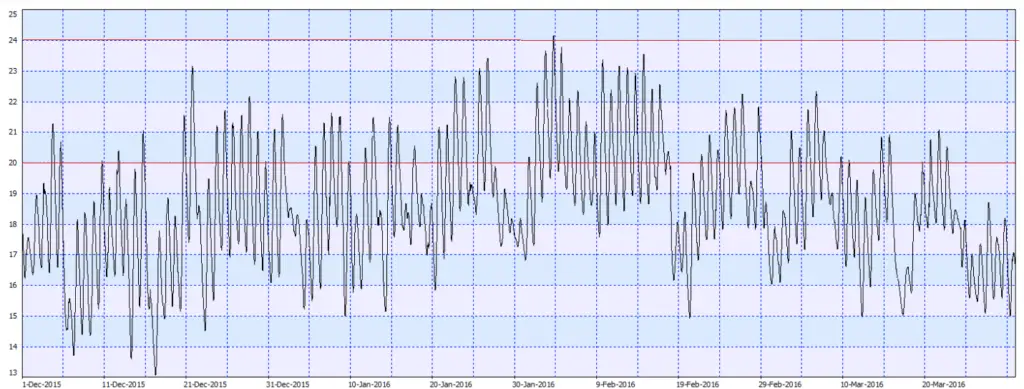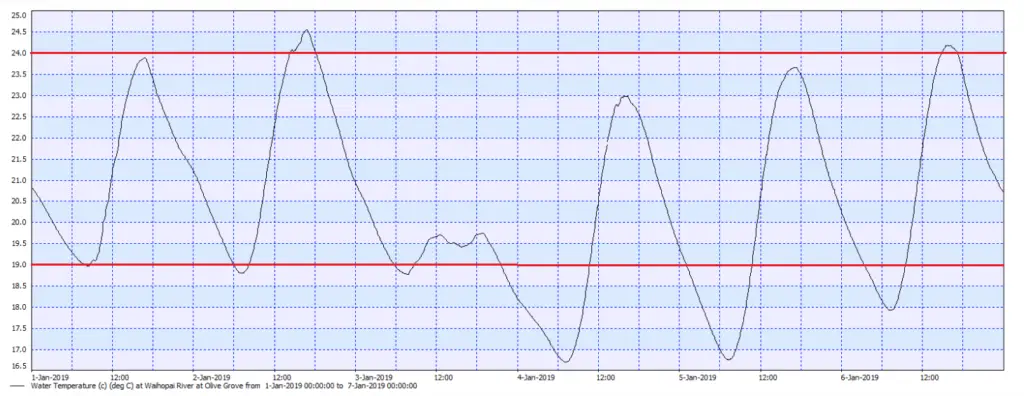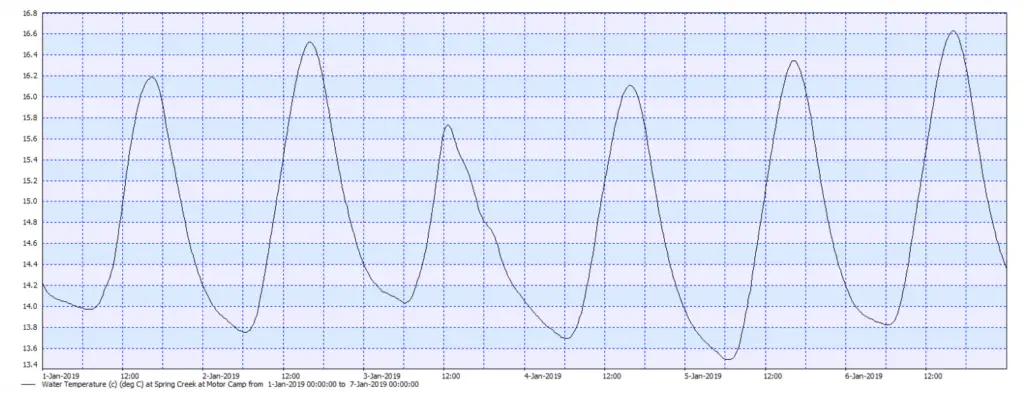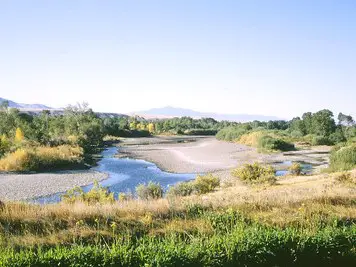With the recent waves of hot weather, I find even walking the dog is exhausting. When it is hot the trout we love to catch also struggle as water temperature raises.
In the middle of summer with high temperatures and low flow, trout fishing is difficult. The trout are not being fussy, as the temperature increases the availability of oxygen in the water decreases and the trout start to suffocate. They are fighting for their survival and feeding is no longer a priority for them.
For this reason many experienced anglers do not target wild brown or rainbow trout when water temperatures exceed 70f (21c).
Check the water temperature before fishing
Whenever I trout fish over the summer months, one of the first things I do on arriving at a river is to check the temperature with a small thermometer I always clip to my vest.
I like to take the water temperature in about knee deep water and a meter down (just over waist depth). I leave the thermometer in the water for several minutes to get an accurate reading of the water temperature. I use that time, to try to spot any feeding trout. So it is time well spent. If the water temperature is too warm, I pack away my trout gear and make other plans for the day. These could include targeting different species or moving to a colder river.
In the chart below, I have listed the optimal water temperature for trout fishing. I also list the temperature where trout start to suffer heat stress. They slow down and become reluctant to feed. Where possible they seek out the coolest parts of the stream.
In the chart below I included the temperature where trout are likely to die if they are exposed to it for more than several hours.
How hot is too hot for trout fishing?
| Optimal Feeding temperature | Temperature trout become stressed | Lethal temperature | |
| Brook Trout | 44-64f (6-18c) | 65f (18c) | 70f (21c) |
| Cutthroat trout | 39-59f (4-15c) | 60f (15.5c) | 68f (20c) |
| Rainbow trout | 44-67f (6-19c) | 68f (20c) | 75f (24c) |
| Brown trout | 44-67f (6-19c) | 68f (20c) | 75f (24c) |
| Lake trout | 40-59f (4-15c) | 65f (18c) | |
| Dolly Varden | 59f (15c) | ||
| Lenok(Manuchiran trout) | (<18c) | 68f (20c) |
Why I never trout fish in warm water?
When the water is above the stress point (68f/20c for brown trout) they become reluctant to feed and often become sluggish. As water temperature raise, the amount of oxygen in the water decreases. Simply, trout and other fish find it harder to breathe.
Any exercise, whether it is feeding, or fighting for their life on the end of a fishing line becomes much more exhausting for them.
The chance of fatalities among released trout greatly increases. The longer, and more stressful the fight the lower the survival rate becomes. Any bleeding nearly always proves fatal when the water temperature is above the stress point.
How to catch trout in warmer conditions.
I accept not all trout anglers practice catch and release fishing. Most stock trout are destined for the dinner table. In these cases, I can understand why some anglers might still continue to fish when the water starts to warm.
So if you are fishing for the pot, there is some advice to improve your chances of success. When the water is warm, trout predominantly try and seek out the area of the river with the most dissolved oxygen.
Many trout lay at the bottom of deep pools, down deep the water is slightly cooler. So the trout cling close to the bottom. Bouncing a lure or fly across the rocks might bring some success. Trout also seek out tributaries or spring eruption zones. So anywhere with cooler water temperatures is more likely to be holding trout.
The other thing trout do is seek out more aerated water normally in ripples or rapids. As the water warms, trout leave the slower following pools and move into the ripples. Feeding there takes more energy, but higher oxygen levels compensate for it.
Time of day influence on water temperature.

Just like the air temperature, the water warms during the day and cools down at night. The temperature of water changes slower than air, meaning the coolest water temperature is usually around mid morning. While the hottest temperatures are typically late afternoon. For the fishermen, it means the best time to fish during the summer is early morning. During hotter days it might mean heading home by 10am.
In some rivers the temperature can fluctuate by 4-5 degrees between afternoon and early morning. So in early summer, when the water temperature is approaching the stress point, choosing to fish at night, or better still in the morning, can bring more success.
By the middle of summer, even early morning temperatures might be stressful. The chart above shows the daily fluctuations in water temperatures for a large freestone river in the summer of 2015 (southern hemisphere).
Releasing trout in hot weather.
When fishing over the summer, minimize the amount of time the trout spend out of the water. Ideally, keep the trout’s gills submerge while removing the hook. Summer when the trout are already struggling is not a time for trout selfies.
I also advise using slightly heavier fishing line or leader, to speed up fight time. The longer the fight goes on, the greater the risk a trout will suffer from exhaustion. Summer is not the time of year to go chasing line class records.
Where to trout fish in hot weather?
The best option when water temperatures are too warm is to seek out a stream or lake with cooler water. Generally, shallow, rain fed rivers warm the quickest. While deep, and spring fed streams take longer to heat up. In the next section I highlight the temperature difference between a shallow river and a spring creek.
Comparing water temperature in a Spring Creek with a freestone river
My local council records the temperatures of several rivers, that makes it easy to track the temperature differences between a spring fed creek and surface flow river over the summer months. Both contain populations of wild brown trout and only 20km separates them.
For comparison, I compare the same one week, midsummer period in both waterways.

The surface flow river peaked at over 24.5 degrees Celsius during the day before dropping to 19 degrees in the early morning. A thunderstorm on the 3rd caused the temperature to stabilize for one day, but the high temperatures quickly bounced back. I personally will be hesitant to target trout when the average water temperature is so high.
What is more shocking, nearly the entire week water temperature was warm enough that the resident trout will experience stress. Water temperature even got above 24 degrees which can be lethal for brown trout. The two red lights indicate when the resident brown trout start to experience stress, and when temperatures start to become fatal.

The nearby Spring Creek water temperature is much more stable. It never got above 17 degrees Celsius and was chilly in the early morning. The water temperature was never outside the optimal survival temperature for brown trout. The trout which lived in the Spring Creek were never under stress. I went back and check 20 years of records, and even during the hottest heatwaves and driest droughts water temperatures never got above 18 degrees, the other river reached 27.5.
Spring creeks are a great refuge for trout in hot weather because it is unlikely that the water temperature gets high enough to cause stress.
I have spent a lot of time fishing, and swimming in that river. I know for a fact that many fish, both natives and trout, do not survive the summer. I only fish there early spring or late in the fall.
I suppose some might ask, if 24 degree water is lethal for trout then how do trout survive in the river at all? The answer is that not all of the river will be that hot, there will be pockets of water, maybe in the depth of shady holes, or near spring fed tributaries that stay cooler allowing the trout to survive. But it will still be a struggle for them, and any stress due to being caught will likely prove fatal.
Alpine Lakes and Streams offer excellent trout fishing
It is quite well know that air temperature decreases with elevation. All things being equal the higher we go the cooler it gets.
In fine conditions, So no cloud or precipitation temperature decreases approximately 5.4°F for every 1,000 feet increase in elevation. In metric, that is 9.8°C per 1,000 meters. An easy but somewhat rough way to remember is forever 100 meters temperature feels about 1 degree cooler.
What does that mean for trout fishing, and water temperature. Simply, the lower temperatures at elevation means the lakes and streams stay cooler. So when the summer is hot, it can be well worthwhile to make the drive high into the mountains and enjoy some quality fishing in mountain lakes. .
Trout live at surprisingly high altitudes. I know of trout lakes 12,800 feet above sea level. That is 3900m. Even on the hottest of summer days, there will still be a chill in the air. Make sure to check your regulations before leaving home, some alpine fisheries have very short seasons which can differ widely from the low country.
Trout occur over much to wide of a geographic region for anyone to know all of the locations. I do know that the west cost enjoys an abundance of alpine lakes, with Washington state alone having over 1,600 high mountain lakes.
While the mountains might not be as high, the east coast also has some quality high altitude fisheries such as the Deboullie Preserve in Maine alongside many secrets within the Appalachian mountains. In my native New Zealand, I usually head to one of my favorite headwater fisheries or mountain lakes.
How to catch trout in hot weather?
When the water is warm, the trout become sluggish and unwilling to feed. Most catch and release anglers choose to stay home rather than putting the trout through a potentially fatal fight. When fishing for stock trout there are a few hints to improve your chances.
Present natural baits right to the trout
Trout are very reluctant to feed, so they are likely to only respond to the most tempting looking morsels. Fly fishermen should reach for the most lifelike lures and flies in their box.
It is more challenging for spin fishermen. Trout often ignore a buzzing spinner or darting jerkbait. They simply do not have the energy to give chase. So it is time to get out the soft plastics which are very lifelike. Or go one step further and use real bait. It is impossible to get more natural than half a night crawler on a hook.
The next piece of the puzzle is the correct presentation. Trout suffering stress is unlikely to swim far, so you must present the bait to them. try to float or present it as close to the fish’s mouth as possible. This is the time of year for accurate casts and precision. Make sure any retrieves are slow, give the trout plenty of time to respond.

